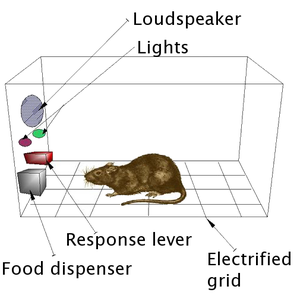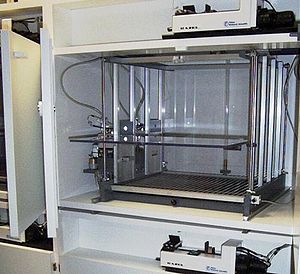
Skinner box
Encyclopedia


Laboratory equipment
Laboratory equipment refers to the various tools and equipment used by scientists working in a laboratory. These include tools such as Bunsen burners, and microscopes as well as speciality equipment such as operant conditioning chambers, spectrophotometers and calorimeters...
used in the experimental analysis of behavior
Experimental analysis of behavior
The experimental analysis of behavior is the name given to the school of psychology founded by B.F. Skinner, and based on his philosophy of radical behaviorism. A central principle was the inductive, data-driven examination of functional relations, as opposed to the kinds of hypothetico-deductive...
to study animal behavior. The operant conditioning chamber was created by B. F. Skinner
B. F. Skinner
Burrhus Frederic Skinner was an American behaviorist, author, inventor, baseball enthusiast, social philosopher and poet...
while he was a graduate student at Harvard University
Harvard University
Harvard University is a private Ivy League university located in Cambridge, Massachusetts, United States, established in 1636 by the Massachusetts legislature. Harvard is the oldest institution of higher learning in the United States and the first corporation chartered in the country...
(Masters in 1930 and doctorate in 1931). It is used to study both operant conditioning
Operant conditioning
Operant conditioning is a form of psychological learning during which an individual modifies the occurrence and form of its own behavior due to the association of the behavior with a stimulus...
and classical conditioning
Classical conditioning
Classical conditioning is a form of conditioning that was first demonstrated by Ivan Pavlov...
.
Purpose
An operant conditioning is done by applying a principle called Law of Effect, when a behavior has good consequences, it will tend to be repeated by the subject while bad consequences will tend to be not repeated.An operant conditioning chamber permits experimenters to study behavior conditioning (training) by teaching a subject animal to perform certain actions (like pressing a lever) in response to specific stimuli, like a light or sound signal. When the subject correctly performs the behavior, the chamber mechanism delivers food or another reward. In some cases, the mechanism delivers a punishment for incorrect or missing responses. With this apparatus, experimenters perform studies in conditioning and training through reward/punishment mechanisms.
Structure
The structure forming the shell of a chamber is a box large enough to easily accommodate the organismOrganism
In biology, an organism is any contiguous living system . In at least some form, all organisms are capable of response to stimuli, reproduction, growth and development, and maintenance of homoeostasis as a stable whole.An organism may either be unicellular or, as in the case of humans, comprise...
being used as a subject. (Commonly used model organism
Model organism
A model organism is a non-human species that is extensively studied to understand particular biological phenomena, with the expectation that discoveries made in the organism model will provide insight into the workings of other organisms. Model organisms are in vivo models and are widely used to...
s include rodent
Rodent
Rodentia is an order of mammals also known as rodents, characterised by two continuously growing incisors in the upper and lower jaws which must be kept short by gnawing....
s—usually lab rats
Brown Rat
The brown rat, common rat, sewer rat, Hanover rat, Norway rat, Brown Norway rat, Norwegian rat, or wharf rat is one of the best known and most common rats....
—pigeons, and primate
Primate
A primate is a mammal of the order Primates , which contains prosimians and simians. Primates arose from ancestors that lived in the trees of tropical forests; many primate characteristics represent adaptations to life in this challenging three-dimensional environment...
s). It is often sound-proof and light-proof to avoid distracting stimuli.
Operant chambers have at least one operandum (or "manipulandum"), and often two or more, that can automatically detect the occurrence of a behavior
Behavior
Behavior or behaviour refers to the actions and mannerisms made by organisms, systems, or artificial entities in conjunction with its environment, which includes the other systems or organisms around as well as the physical environment...
al response or action. Typical operanda for primates and rats are response levers; if the subject presses the lever, the opposite end moves and closes a switch that is monitored by a computer or other programmed device. Typical operanda for pigeons and other bird
Bird
Birds are feathered, winged, bipedal, endothermic , egg-laying, vertebrate animals. Around 10,000 living species and 188 families makes them the most speciose class of tetrapod vertebrates. They inhabit ecosystems across the globe, from the Arctic to the Antarctic. Extant birds range in size from...
s are response keys
Telegraph key
Telegraph key is a general term for any switching device used primarily to send Morse code. Similar keys are used for all forms of manual telegraphy, such as in electrical telegraph and radio telegraphy.- Types of keys :...
with a switch that closes if the bird pecks at the key with sufficient force
Force
In physics, a force is any influence that causes an object to undergo a change in speed, a change in direction, or a change in shape. In other words, a force is that which can cause an object with mass to change its velocity , i.e., to accelerate, or which can cause a flexible object to deform...
. The other minimal requirement of a conditioning chamber is that it has a means of delivering a primary reinforcer or unconditioned stimulus like food (usually pellets) or water. It can also register the delivery of a conditioned reinforcer, such as an LED (see Jackson & Hackenberg 1996 in the Journal of the Experimental Analysis of Behavior for example) signal as a "token".
Despite such a simple configuration, one operandum and one feeder, it is possible to investigate many psychological phenomena. Modern operant conditioning chambers typically have many operanda, like many response levers, two or more feeders, and a variety of devices capable of generating many stimuli
Stimulus (physiology)
In physiology, a stimulus is a detectable change in the internal or external environment. The ability of an organism or organ to respond to external stimuli is called sensitivity....
, including lights, sounds, music, figures, and drawings. Some configurations use an LCD panel for the computer generation of a variety of visual stimuli.
Operant chambers can also have electrified nets or floors so that electrical charges can be given to the animals; or lights of different colors that give information about when the food is available.
Although the use of shock is not unheard of, approval may be needed in some countries to avoid unnecessary harmful experimentation on animals. Skinner's work did not focus on punishment, and involved a "paw slap" which caused him to conclude, incorrectly, that punishment was ineffective. Works by Azrin, Sidman and others in the 1960s and 1970s showed this was not the case.
Research impact
Skinner's operant chamber allowed him to explore the rate of response as a dependent variable, as well as develop his theory of schedules of reinforcementReinforcement
Reinforcement is a term in operant conditioning and behavior analysis for the process of increasing the rate or probability of a behavior in the form of a "response" by the delivery or emergence of a stimulus Reinforcement is a term in operant conditioning and behavior analysis for the process of...
. If the event increased the number of responses it is said to strengthen its responding and if it decreased the number of responses it weakens the responding. The first operant chambers were attached to cumulative records on drums producing characteristic pauses, scallops, and other lines.
Operant conditioning chambers have become common in a variety of research disciplines including behavioral pharmacology, and whose results inform many disciplines outside of psychology such as behavioral economics.
Application to Games
Slot machineSlot machine
A slot machine , informally fruit machine , the slots , poker machine or "pokies" or simply slot is a casino gambling machine with three or more reels which spin when a button is pushed...
s and online games are sometimes cited as examples of human devices that use sophisticated operant schedules of reinforcement to reward repetitive actions. However, others have also critiqued the application of skinner boxes to game design as incomplete and uninformed by an understanding of evolutionary psychology
Evolutionary psychology
Evolutionary psychology is an approach in the social and natural sciences that examines psychological traits such as memory, perception, and language from a modern evolutionary perspective. It seeks to identify which human psychological traits are evolved adaptations, that is, the functional...
.
Skinner Box
Skinner is noted to have said that he didn't want to be an eponymEponym
An eponym is the name of a person or thing, whether real or fictitious, after which a particular place, tribe, era, discovery, or other item is named or thought to be named...
. The term Skinner Box is considered by some to be pejorative, and is probably most commonly used by those who are not in the discipline of Experimental analysis of behavior
Experimental analysis of behavior
The experimental analysis of behavior is the name given to the school of psychology founded by B.F. Skinner, and based on his philosophy of radical behaviorism. A central principle was the inductive, data-driven examination of functional relations, as opposed to the kinds of hypothetico-deductive...
or in psychology.
External links
- From Pavlov to Skinner Box - background and experiment

